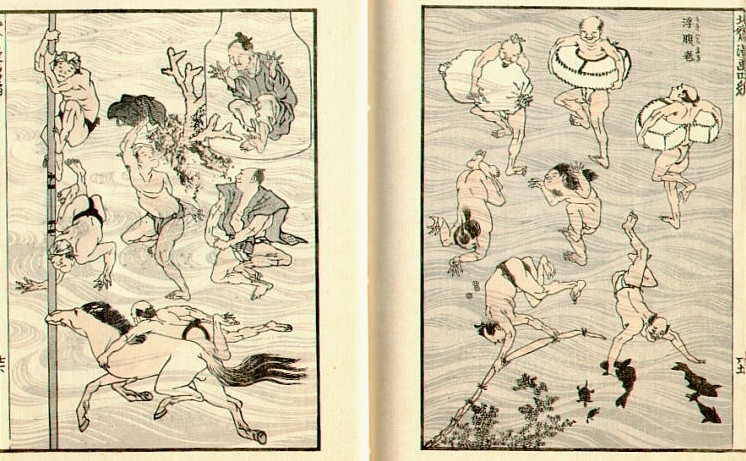#French #Fascination #Japanese #Culture #Japonisme #Mysterious #Geisha #Locket
.
The word Japonism (from the French word Japonisme) is the influence of Japanese aesthetics, art, and fashion on Western culture. The term is used particularly to refer to Japanese influence on European art, most notably the Impressionist Movement. In France Japonisme referred to a style of French design found in the fine arts and it was a natural progression that this country’s master silversmiths would be inspired by this exotic theme to create the most coveted objet d’art. The opening of Japan in the Meiji Restoration of the 1860s attracted curiosity from the West. Literally the opening of the country after a period of national isolation started a craze for collecting Japanese art – art encompassing – fashion, culture and design. Some porcelain exported to France was wrapped in copies of a sketchbook known as the Hokusai Manga.
THE HOKUSAI MANGA
The Hokusai Manga ( Hokusai’s Sketches) is a collection of sketches which were block-printed in three colours – flesh pink, black and grey. The sketches show daily life in Japan, the natural and supernatural world.
The first volume was published in 1814 when Hokusai was fifty five years old.
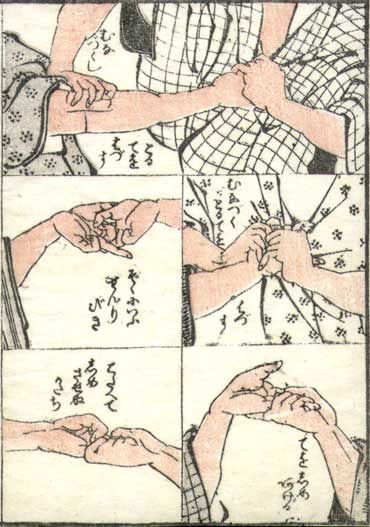
HOKUSAI MANGA SELF DEFENSE TECHNIQUES
To understand the situation we first have to ask ourselves the question below:
Why was Japan closed off to some European trade for over 250 years?
From 1602 – 1853 the foreign policy of the Japanese Tokugawa shogunate was one of partial isolation and strict control. The term Sakoku, meaning locked-in country, was used to describe how Japan attempted to limit European colonial expansion into Japan.
Spain and Portugal were seen as a tremendous threat to the Japanese way of life, trade and spirituality. The spread of Catholicism created a threat to the stability of the region.
The Empress Meisho (1624–96) was concerned about the proselytising process in which the Spanish and Portuguese were converting the New World to Catholicism. Protestant Dutch and English diplomats and merchants were only too eager to encourage these fears. At the same time they put forward theories that the English and Dutch merely wished to trade and would not impose their religious beliefs on the Japanese people.
During 1637 – 1638 an uprising of tens of thousands of Japanese peasants who had been converted to Christianity caused the shogunate to expel all the Christian missionaries from Japan. The missionaries would face the death penalty if they dared to return to Japan. The Seclusion Edict of 1636 was written by Nagasaki’s two commissioners.
Extract From The Seclusion Edict Of 1636
No Japanese ship … nor any native of Japan, shall presume to go out of the country; whoever acts contrary to this, shall die, and the ship with the crew and goods aboard shall be sequestered until further orders. All persons who return from abroad shall be put to death. Whoever discovers a Christian priest shall have a reward of 400 to 500 sheets of silver and for every Christian in proportion. All Namban (Portuguese and Spanish) who propagate the doctrine of the Catholics, or bear this scandalous name, shall be imprisoned in the Onra, or common jail of the town. The whole race of the Portuguese with their mothers, nurses and whatever belongs to them, shall be banished to Macao. Whoever presumes to bring a letter from abroad, or to return after he hath been banished, shall die with his family; also whoever presumes to intercede for him, shall be put to death. No nobleman nor any soldier shall be suffered to purchase anything from the foreigner
Other edicts followed.
For example – The Exclusion of the Portuguese in 1639.
However, trade with China was extensive. The port of Nagasaki was the main route for this trade. The area had a dedicated residential area for Chinese merchants and workers. The Dutch East India Company was also granted permission to operate from a base located on an island called Dejima. The island was separated from the city of Nagasaki by a narrow strait. Japanese civilians were only allowed to enter Dejima once they had been granted authorization. Foreigners were not permitted to enter Nagasaki.
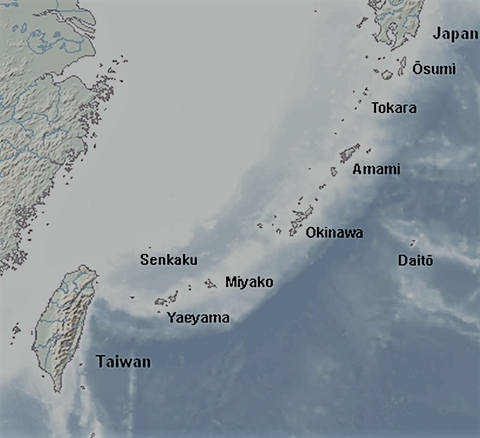
RYUKYU ISLANDS
The Shogunate sought assurances from Dutch merchants that they would not send missionaries to convert the Japanese to Christianity. After these assurances were given Dutch traders were granted permission to trade. The Dutch merchants acted as intermediaries for the Japanese, as did the rulers of the Ryukyu Islands.
Despite their relative isolation the shogunate was keen to learn about inventions and medical discoveries from translated Dutch language books and papers which were purchased from their trading contacts in Dejima.
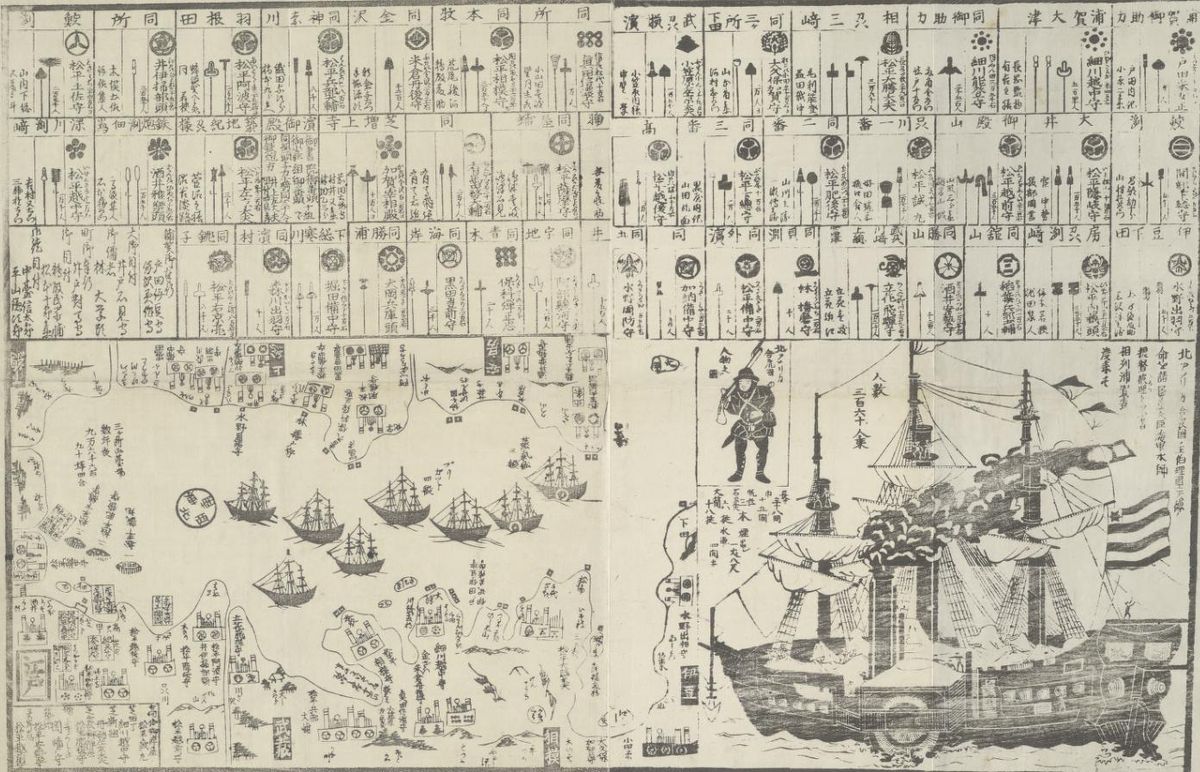
JAPANESE PRINT SHOWING COMMODORE PERRY’S VISIT
Sakoku ended when the American Black Ships commanded by Matthew C. Perry forced the opening of to American trade through a series of treaties, which were known as the Convention of Kanagawa (Kanagawa Treaty). On March 31, 1854, this treaty was signed between the United States of America and the Tokugawa Shogunate, who were threatened with force if they failed to comply.
The term Black Ships was coined by the Japanese which described the pitch blackened hulls of the foreign ships. Applying pitch was a traditional way of sealing the seams of wooden ships.
The opening of trade with the rest of the world followed after similar treaties were signed with other foreign powers. It is thought that initially the woodblock prints came to Europe via Dutch merchants. These prints were both captivating and startlingly different to European eyes.
Fashion designers, jewellers, artists and architects came under their influence and the French craze for Japonisme influenced all aspects of life. In 1867 the Exposition Universelle (Paris) many exhibits brought the Japanese style to the attention of the public who for the most part were enthusiastic about the highly stylized Japanese inspired art and fashion.
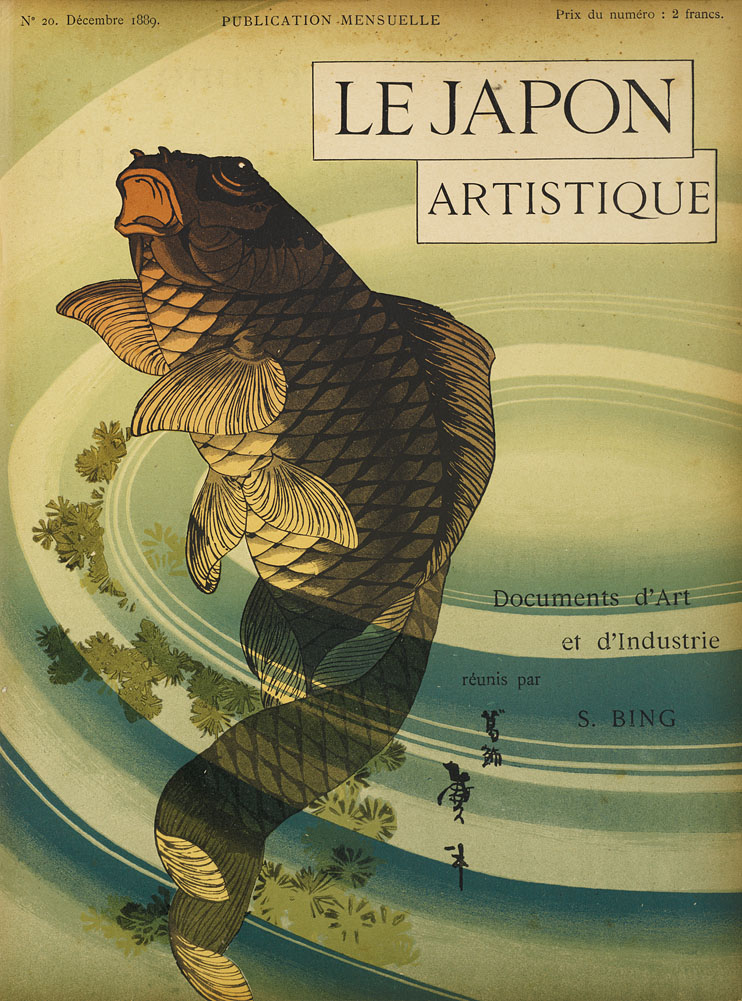
LE JAPON ARTISTIQUE DECEMBER 1889 COVER
In 1888 the German born French art dealer Siegfried Bing began his monthly publications of the magazine Le Japon Artistique. This publication was hugely influential. Many artists, architects, fashion designers and theatrical impresarios sought to create their own Japanese inspired paintings, lithographs, buildings and plays.
Many French artists including Claude Monet, Edouard Manet, Toulouse-Lautrec were delighted and inspired by the images they saw in Le Japon Artistique.
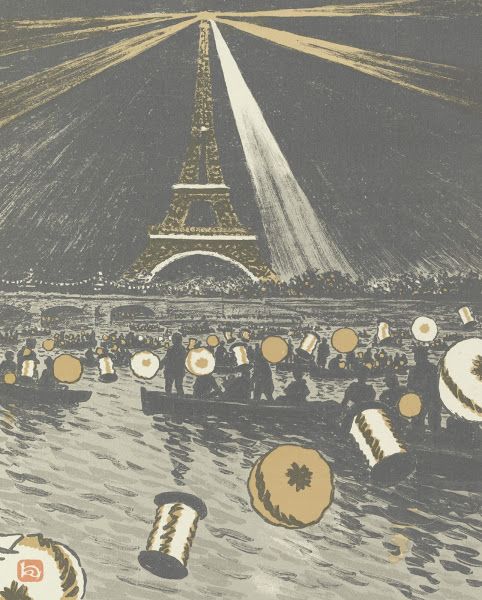
FÊTE SUR LA SEINE LE 14 JUILLET
Henri Rivière 1902
In 1902 Henri Rivière released a series of lithographics which he named Les Trente-six vues de la Tour Eiffel (Thirty-six views of the Eiffel Tower). Each stylish lithograph depicted la Tour Eiffel in the manner of Japonisme at its finest. Stunning images unlike anything seen before. Rivière made his own woodblocks and paints.
La Tour Eiffel was constructed by Gustave Eiffel for the Exposition Universelle in 1889. This magnificent structure was designed to be visible from every quarter.
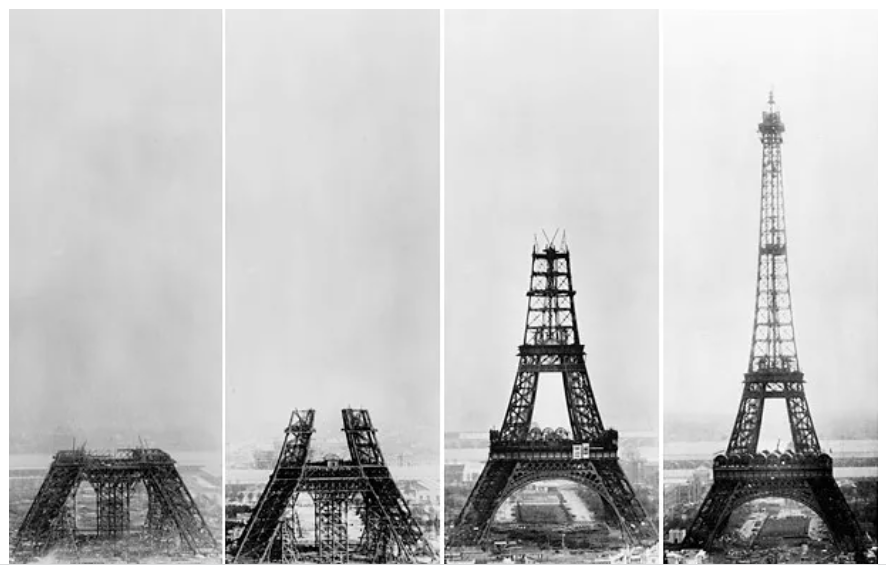
CONSTRUCTION OF LA TOUR EIFFEL
Just before its completion Henri Rivière climbed and photographed the tower. He loved the way the iron girders formed patterns against the city and sky. The fact that he could see through the structure and this allowed for the light to pass through the tower and for sights of Paris to be seen when viewing the tower from any angle.
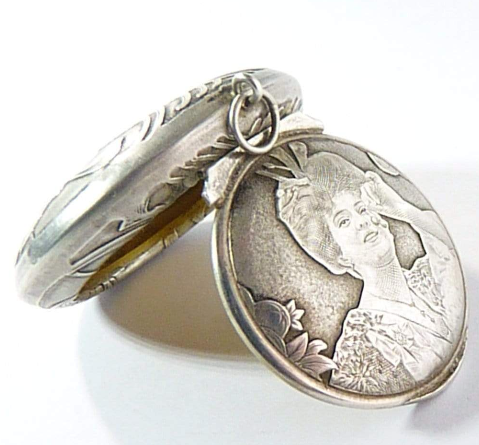
RARE & MYSTERIOUS HALLMARKED SILVER GEISHA LOCKET
A rare authentic Art Nouveau locket with the highly collectible theme of Geisha. The word Japonism (from the French word Japonisme) is the influence of Japanese aesthetics, art, and fashion on Western culture. The term is used particularly to refer to Japanese influence on European art, most notably the Impressionist Movement. In France Japonisme referred to a style of French design found in the fine arts and it was a natural progression that this country’s master silversmiths would be inspired by this exotic theme to create the most coveted objet d’art.
This locket is such a rare find!
Even more intriguing, to date, none of the silver experts we have consulted have been able to identify the French silversmith who created this piece.
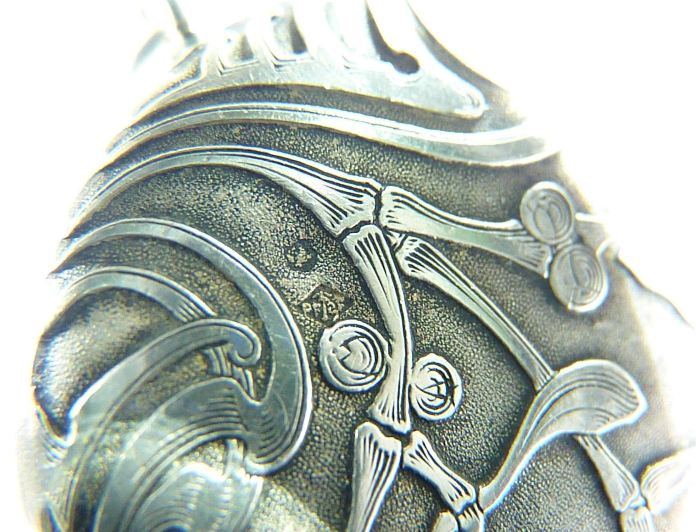
SILVER PURITY & MAKER’S HALLMARKS
The locket is fully hallmarked with the maker’s mark and the crab mark too on the back and also on the lid. We are not sure if this has ever been worn as the condition is remarkably good – it is superb. The vermeil interior is absolutely stunning and without any loss of gold and so we believe this has been kept as a collector’s piece from its creation.
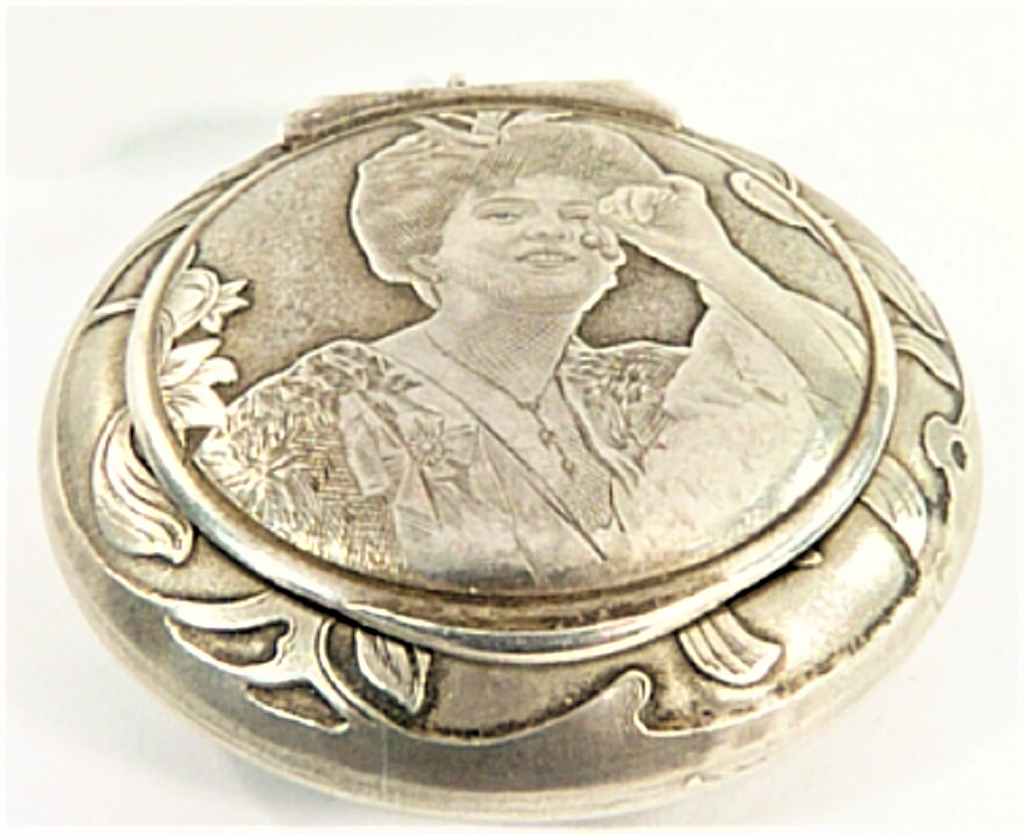
The lid shows a geisha – her hair, facial expression and luxurious clothes finely executed. In her left hand she is holding up what look like cherries but they could be mistletoe as the sides and back have the most gorgeous Art Nouveau repoussage mistletoe.
In Japanese culture cherries symbolise reincarnation and resurrection. The Japanese celebrate a festival called Hanami in which they honour the cherry blossoms. The tree, cherries and the blossom represent a new beginning.
In both France and Japan healing properties and good fortune have been attributed to mistletoe. The Japanese have been known to wear mistletoe in their hair to bring happiness.
Sources:
Wikipedia
Straelen, H. van (1952) Yoshida Shoin, Forerunner of the Meiji Restoration. Leiden: E.J. Brill. pp. 7–8

